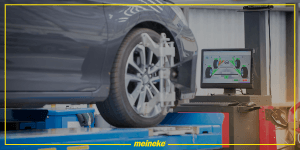August 20, 2018
How To Jump Start A Car Battery The Right Way
Car Battery Dead?
It has probably happened to you before.You go to turn your ignition, and nothing happens. Maybe you hear a few clicks. Another dead car battery? You need to fix this and get your vehicle back on the road – fast. If you are prepared, you already have a good set of jumper cables in your car. Now all you need to do is to learn how to jump start a car battery.
Choosing the Right Jumper Cables
You don’t need many tools to jump a car battery. First, you must find a functioning car to use for the jump-start. Make sure that both car owners are comfortable opening the hood and identifying the battery and battery terminals. Jumper cables are the most popular tool used to jump start cars because they are inexpensive and easy to store. Jumper cables usually come in a variety of lengths, ranging from 10-20 feet. Some people think longer cables are better so that you do not have to move a car with a dead battery. But, while longer cables provide convenience, they may lose power as the longer the cable, the farther the energy has to travel. The gauge of the cable denotes the strength of the cables. The lower the gauge, the thicker the cables and the stronger they are. Gauge six is a standard size for jumper cables.
Safety First
You should consider all safety risks before performing any basic maintenance or repair on your car. First, make sure that small children are in a safe area away from the engine while you are establishing how to jump a dead car battery. Take a moment to read the manual of your car. Some vehicles require extra steps in order to have a successful jump. If you’re unsure of what to do, contact your local Meineke Car Care Center for advice. Assuming that your car will permit a jump, you should be careful to prevent dangerous electric shocks. When you handle the jumper cables, be aware that their function is to transmit electrical current from one car to another. Once one end of the jumper cables is connected to a car, do not touch the metal clamps to anything but the appropriate target. It’s also recommended that you wear a pair of protective glasses in case sparks go flying into the air.
How to Jump a Car Battery
To prepare for the jump:
Step 1: Park the vehicles next to each other.
Park the functioning car so that the vehicles face each other, preferably only about 18 inches apart, but never touching each other. For automatic transmission cars, put the vehicle in park; for a manual transmission, set the vehicle to neutral. Set the parking brakes on both, so neither car moves unexpectedly.

Step 2: Both vehicles should be off. Set the parking brakes
Both cars should be turned off, with keys removed. Set down the jumper cables on the ground, making sure the clamps do not touch each other.

Now, begin attaching the jumper cables:
Open the hood to both cars, and locate the batteries (refer to the owner's manual for battery location) and battery terminals. Usually, the two terminals on each battery will be covered in red or black, with a + or -- sign on top. Look at the batteries and make sure that you can identify which is positive, and which is negative. This distinction is crucial to the success of your jump. If the battery
terminals are dirty, wipe them off with a rag or wire brush.
Step 3: Attach one red clamp to the positive terminal on the dead battery.
Attach the red, positive cable clamp to the positive (+) battery terminal of the dead battery. You want a solid connection to the battery terminal, which may require some initial wiggling of the clamps

Step 4: Attach the other red clamp to the positive terminal on the working battery.
Attach the red, positive cable clamp on the
other side of the jumper cables to the
functioning vehicle's positive (+) battery
terminal

Step 5: Attach the partnered black clamp to the negative terminal on the working battery.
Connect the black, negative cable clamp to the working battery's negative (-) battery terminal.

Step 6: Attach the partnered black clamp to a clean nut or bolt on the engine block.
Walk over to the car with the dead battery. Do not connect the black, negative cable clamp to the dead battery. Instead, attach that clamp to an unpainted, metal part of the car such as a shiny, clean nut on the engine block. This will help ensure a safe jump.

Know How Long to Charge a Dead Car Battery
Now you're ready to attempt the jump-start. Follow the instructions below to find out how and how long to charge your car's dead battery:
Step 7: Start the working vehicle and let it run for a few seconds.
Start the working vehicle. Wait a minute or so. Depending on the age of the battery and how long since it died, you may need to let the car run for a minute or two to get the jump to work.

Step 8: Start the dead vehicle. It should turn on.
Try starting the dead car. If the car doesn't start, allow the working vehicle to charge the battery for an additional minute or two before attempting again.

Step 9: If it doesn't turn on, try revving the engine of the working vehicle.
In some instances, slightly revving the engine of the working car while charging the dead battery may help.

Step 10: Disconnect the black jumper cables first, then disconnect the red ones.
Once the dead car is running, you may disconnect the jumper cables, starting with the black, negative cable clamps. Do not let the clamps touch each other while any part of the cables is still attached to a car.

Step 11: Take a short drive to help recharge the battery.
Now, take a short drive. This will allow the battery to build up a charge. This driving allows the vehicle's alternator to charge the battery and ensures that your vehicle does not die again once you turn it off.

If the Jump-Start Fails
If the jump fails to start your car after a few short attempts, or if the car starts but then dies again, you have some other issues you need to address. Most batteries are rated to last 4-6 years. If your battery is old, you may need to replace it. If the battery should be working well, you should consider other possible problems with other components, including:
- fuses
- battery corrosion
- faulty alternator
- ignition switch
- starter connection
When you do not know what is wrong, your best bet is to take the car in to your local Meineke Car Care Center for service and repair. Many centers conveniently offer free battery inspections and diagnostic scans and can help you understand your vehicle's issues.
Dealing with a dead car battery is a pain. Luckily, getting your car working again is not terribly difficult. By following these instructions, using your jumper cables sensibly, practicing safety and addressing other potential concerns, your car will run better, be safer, and last longer. For professional advice and assistance,
talk to your local mechanic at your neighborhood Meineke Car Care Center.



